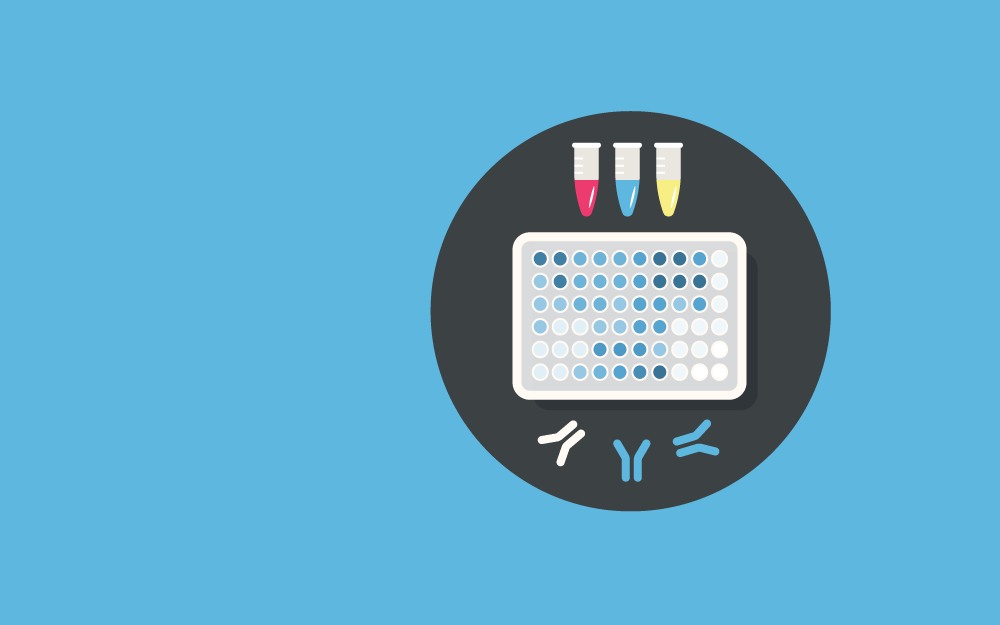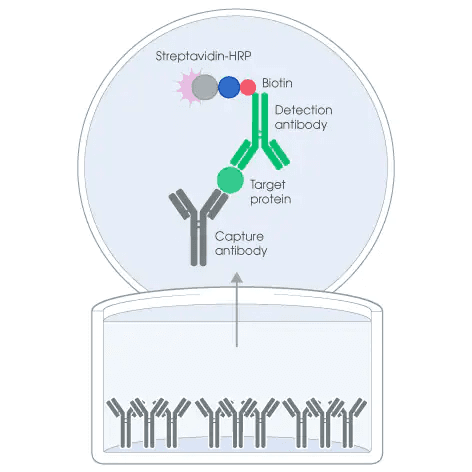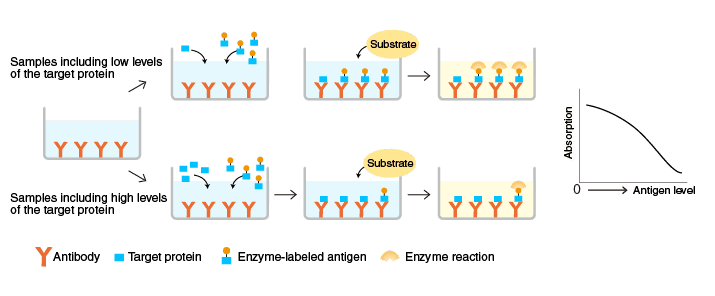

ELISA is short for enzyme-linked immunosorbent assay.[1] It’s an analytical biochemical assay used to study antibodies, glycoproteins, peptides, proteins, and hormones.
A solid-phase enzyme immunoassay (EIA) in this assay is used to detect the targeted protein in a liquid sample using targeted antibodies. The antigens are attached to the surface, and the antibodies are applied over it. The specific antibody and antigen bind while the other unbound antibodies are washed off the solution.
The antibody-antigen reaction is measured by adding a substrate that produces a color change, which is used to measure the analyte concentration in the samples.
For decades, ELISA has been used as one of the essential tools in plant pathology, medicine, and biotechnology.[2] Moreover, it’s a go-to assay for many industries for quality checks of their biological products.
It’s carried out in a 96-well plate and can measure and study multiple samples in a single experiment.[3] It’s different from other antibody assays because of its data reproducibility and quantitative results.
This article discusses the working principle of enzyme-linked immunosorbent assays (ELISA), its types, advantages and limitations, and their applications in life science labs and industries.
ELISA works on the principle of antigen-antibody interactions. The antibody is a protein produced by the organism’s immune system and an antigen is a protein coming from any other foreign source.
In ELISA, special absorbent plates, such as NUNC Immuno plates, are used, which allows antigens or antibodies to stick to the plate surface.[4] In most cases, antigens are stuck to the surface and specific antibodies, conjugated with an enzyme or fluorophore, bind to the antigen.[5] This initiate a reaction that can be detected as a color change.
The more the intensity of the signal, the more the concentration of the protein. Thus, ELISA is an effective assay to measure antigen-antibody concentration compared to other immunological assays.

Figure: An illustration of the basic ELISA setup showing how the assay works.[5]
ELISA tests are of many types[6] based on the bonding of antigens or antibodies and how they are used in the process.
In this assay, antigens or proteins are immobilized on the plate surface. The plate is incubated with a solution of enzyme-labeled antibody.[6] The specific antibody binds to the specific antigen and the reaction is observed when a substrate is added, which binds the enzyme-conjugated antibody and gives a signal. The intensity of the signal is used to measure the concentration of the analyte in the sample.
It’s a fast and simple protocol; however, it’s less specific as only one antibody is used in the process and might produce high background, that is higher color development or optical density readings.[6]

The indirect ELISA has steps similar to direct ELISA, with an additional amplification detection step.[6] In the process, analytes or antibodies are immobilized in the wells of the microplate, which are then incubated with antibodies having the ability to bind to antigens.
The plates are first incubated with primary antibodies followed by secondary antibodies. The primary antibodies are unconjugated and bind with specific antigens, whereas the secondary antibodies are conjugated with enzymes or fluorophores and bind to primary antibodies.[6]
Adding the substrate to the plate produces a signal that’s measured to calculate the amount of antigen bound to the antibodies in the well.

Figure: An illustration of the process of indirect ELISA and the reaction involved.[6]
It’s the most common type of ELISA used in labs. In Sandwich ELISA, antibodies, rather than antigens, are immobilized on the surface of the well plates.[6] The plates are first incubated with the target protein, followed by antibodies conjugated with enzymes and specific to the target protein.
Both the immobilized antibodies and conjugated antibodies recognize different epitopes on the bound antigen.[6] After the substrate is added, the reaction produces a signal that is directly proportional to the amount of antigen or analyte in the sample.

Figure: An illustration of the process of sandwich ELISA and the reaction involved.[6]
This type of ELISA is used for small molecules. In this process, the antibodies are immobilized in the wells of the microplate and incubated with antigens.[6] Then, a conjugated antigen, instead of a conjugated antibody, is used in this process.
The less the target antigen is present in the sample, the more conjugated antigen-antibody complex, and the more signal will be detected. However, if the concentration of the target antigen in the sample is higher, the binding of the conjugated antigen and antibody will be lesser, and the signal detected will be low.[6] This is how the concentration of the targeted analytes is studied in the desired sample.

Figure: An illustration of the process of competitive ELISA and the reactions involved.[6]
Here are the general steps to conducting ELISA experiments. However, it needs to be tweaked based on the specific experiments:[7]
ELISA tests or assays have extensive applications in life sciences, biotech, and medical fields. Some of them are:[1]
ELISA is a biochemical assay used to detect the presence and absence of antigens, proteins, peptides, glycoproteins, and hormones.
The assay works on the principle of specific binding of antigens with their antibodies. This interaction is measured by using enzymes that produce a signal based on the amount of antigen-antibody binding. The four key steps involved in the assay include coating, blocking, detection, and plate readout.
There are four major types of ELISA – direct, indirect, competitive, and sandwich. All of these are used in lab workflows based on the experimental goals. The assay has application in a range of life sciences fields, starting from research studies involving antigen and antibodies detection, and disease identification, to allergen detection in food samples.
There are several ranges of affordable and effective ELISA kits available in Conduct Science, these include a commercial ELISA kit for Exonuclease 1 and serum amyloid A.
In behavioral neuroscience, the Open Field Test (OFT) remains one of the most widely used assays to evaluate rodent models of affect, cognition, and motivation. It provides a non-invasive framework for examining how animals respond to novelty, stress, and pharmacological or environmental manipulations. Among the test’s core metrics, the percentage of time spent in the center zone offers a uniquely normalized and sensitive measure of an animal’s emotional reactivity and willingness to engage with a potentially risky environment.
This metric is calculated as the proportion of time spent in the central area of the arena—typically the inner 25%—relative to the entire session duration. By normalizing this value, researchers gain a behaviorally informative variable that is resilient to fluctuations in session length or overall movement levels. This makes it especially valuable in comparative analyses, longitudinal monitoring, and cross-model validation.
Unlike raw center duration, which can be affected by trial design inconsistencies, the percentage-based measure enables clearer comparisons across animals, treatments, and conditions. It plays a key role in identifying trait anxiety, avoidance behavior, risk-taking tendencies, and environmental adaptation, making it indispensable in both basic and translational research contexts.
Whereas simple center duration provides absolute time, the percentage-based metric introduces greater interpretability and reproducibility, especially when comparing different animal models, treatment conditions, or experimental setups. It is particularly effective for quantifying avoidance behaviors, risk assessment strategies, and trait anxiety profiles in both acute and longitudinal designs.
This metric reflects the relative amount of time an animal chooses to spend in the open, exposed portion of the arena—typically defined as the inner 25% of a square or circular enclosure. Because rodents innately prefer the periphery (thigmotaxis), time in the center is inversely associated with anxiety-like behavior. As such, this percentage is considered a sensitive, normalized index of:
Critically, because this metric is normalized by session duration, it accommodates variability in activity levels or testing conditions. This makes it especially suitable for comparing across individuals, treatment groups, or timepoints in longitudinal studies.
A high percentage of center time indicates reduced anxiety, increased novelty-seeking, or pharmacological modulation (e.g., anxiolysis). Conversely, a low percentage suggests emotional inhibition, behavioral avoidance, or contextual hypervigilance. reduced anxiety, increased novelty-seeking, or pharmacological modulation (e.g., anxiolysis). Conversely, a low percentage suggests emotional inhibition, behavioral avoidance, or contextual hypervigilance.
The percentage of center time is one of the most direct, unconditioned readouts of anxiety-like behavior in rodents. It is frequently reduced in models of PTSD, chronic stress, or early-life adversity, where animals exhibit persistent avoidance of the center due to heightened emotional reactivity. This metric can also distinguish between acute anxiety responses and enduring trait anxiety, especially in longitudinal or developmental studies. Its normalized nature makes it ideal for comparing across cohorts with variable locomotor profiles, helping researchers detect true affective changes rather than activity-based confounds.
Rodents that spend more time in the center zone typically exhibit broader and more flexible exploration strategies. This behavior reflects not only reduced anxiety but also cognitive engagement and environmental curiosity. High center percentage is associated with robust spatial learning, attentional scanning, and memory encoding functions, supported by coordinated activation in the prefrontal cortex, hippocampus, and basal forebrain. In contrast, reduced center engagement may signal spatial rigidity, attentional narrowing, or cognitive withdrawal, particularly in models of neurodegeneration or aging.
The open field test remains one of the most widely accepted platforms for testing anxiolytic and psychotropic drugs. The percentage of center time reliably increases following administration of anxiolytic agents such as benzodiazepines, SSRIs, and GABA-A receptor agonists. This metric serves as a sensitive and reproducible endpoint in preclinical dose-finding studies, mechanistic pharmacology, and compound screening pipelines. It also aids in differentiating true anxiolytic effects from sedation or motor suppression by integrating with other behavioral parameters like distance traveled and entry count (Prut & Belzung, 2003).
Sex-based differences in emotional regulation often manifest in open field behavior, with female rodents generally exhibiting higher variability in center zone metrics due to hormonal cycling. For example, estrogen has been shown to facilitate exploratory behavior and increase center occupancy, while progesterone and stress-induced corticosterone often reduce it. Studies involving gonadectomy, hormone replacement, or sex-specific genetic knockouts use this metric to quantify the impact of endocrine factors on anxiety and exploratory behavior. As such, it remains a vital tool for dissecting sex-dependent neurobehavioral dynamics.
The percentage of center time is one of the most direct, unconditioned readouts of anxiety-like behavior in rodents. It is frequently reduced in models of PTSD, chronic stress, or early-life adversity. Because it is normalized, this metric is especially helpful for distinguishing between genuine avoidance and low general activity.
Environmental Control: Uniformity in environmental conditions is essential. Lighting should be evenly diffused to avoid shadow bias, and noise should be minimized to prevent stress-induced variability. The arena must be cleaned between trials using odor-neutral solutions to eliminate scent trails or pheromone cues that may affect zone preference. Any variation in these conditions can introduce systematic bias in center zone behavior. Use consistent definitions of the center zone (commonly 25% of total area) to allow valid comparisons. Software-based segmentation enhances spatial precision.
Evaluating how center time evolves across the duration of a session—divided into early, middle, and late thirds—provides insight into behavioral transitions and adaptive responses. Animals may begin by avoiding the center, only to gradually increase center time as they habituate to the environment. Conversely, persistently low center time across the session can signal prolonged anxiety, fear generalization, or a trait-like avoidance phenotype.
To validate the significance of center time percentage, it should be examined alongside results from other anxiety-related tests such as the Elevated Plus Maze, Light-Dark Box, or Novelty Suppressed Feeding. Concordance across paradigms supports the reliability of center time as a trait marker, while discordance may indicate task-specific reactivity or behavioral dissociation.
When paired with high-resolution scoring of behavioral events such as rearing, grooming, defecation, or immobility, center time offers a richer view of the animal’s internal state. For example, an animal that spends substantial time in the center while grooming may be coping with mild stress, while another that remains immobile in the periphery may be experiencing more severe anxiety. Microstructure analysis aids in decoding the complexity behind spatial behavior.
Animals naturally vary in their exploratory style. By analyzing percentage of center time across subjects, researchers can identify behavioral subgroups—such as consistently bold individuals who frequently explore the center versus cautious animals that remain along the periphery. These classifications can be used to examine predictors of drug response, resilience to stress, or vulnerability to neuropsychiatric disorders.
In studies with large cohorts or multiple behavioral variables, machine learning techniques such as hierarchical clustering or principal component analysis can incorporate center time percentage to discover novel phenotypic groupings. These data-driven approaches help uncover latent dimensions of behavior that may not be visible through univariate analyses alone.
Total locomotion helps contextualize center time. Low percentage values in animals with minimal movement may reflect sedation or fatigue, while similar values in high-mobility subjects suggest deliberate avoidance. This metric helps distinguish emotional versus motor causes of low center engagement.
This measure indicates how often the animal initiates exploration of the center zone. When combined with percentage of time, it differentiates between frequent but brief visits (indicative of anxiety or impulsivity) versus fewer but sustained center engagements (suggesting comfort and behavioral confidence).
The delay before the first center entry reflects initial threat appraisal. Longer latencies may be associated with heightened fear or low motivation, while shorter latencies are typically linked to exploratory drive or low anxiety.
Time spent hugging the walls offers a spatial counterbalance to center metrics. High thigmotaxis and low center time jointly support an interpretation of strong avoidance behavior. This inverse relationship helps triangulate affective and motivational states.
By expressing center zone activity as a proportion of total trial time, researchers gain a metric that is resistant to session variability and more readily comparable across time, treatment, and model conditions. This normalized measure enhances reproducibility and statistical power, particularly in multi-cohort or cross-laboratory designs.
For experimental designs aimed at assessing anxiety, exploratory strategy, or affective state, the percentage of time spent in the center offers one of the most robust and interpretable measures available in the Open Field Test.
Written by researchers, for researchers — powered by Conduct Science.








Monday – Friday
9 AM – 5 PM EST
DISCLAIMER: ConductScience and affiliate products are NOT designed for human consumption, testing, or clinical utilization. They are designed for pre-clinical utilization only. Customers purchasing apparatus for the purposes of scientific research or veterinary care affirm adherence to applicable regulatory bodies for the country in which their research or care is conducted.